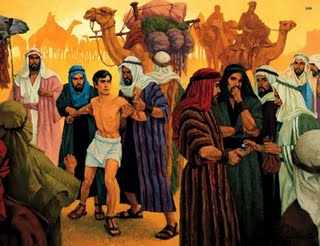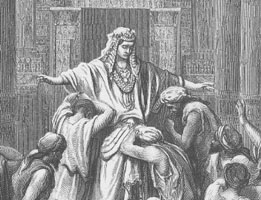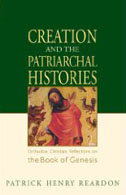October 2009 - Vol. 33
.Narrative,
Theology, and the Christian Hope
The following literary and theological reflections on the Old Testament story of Joseph have no other purpose than Christian edification. .. Although this reading follows sympathies that are very personal, I hope that they are not merely idiosyncratic and that others may find them helpful.1 Perhaps one will best think of the following lines as a sort of meditation. Any reader of Genesis with even a little feel for structure and style will recognize that he has arrived at something new when he starts through the long Joseph narrative (Genesis 37–50). Although all of the stories in Genesis are tied together by unifying historico-theological themes and a panoramic epic construction, there are two very clear points of style in which this long story of Joseph stands out uniquely with respect to the narratives that precede it. The first stylistic point has to do with construction. .. No one of its parts is of interest without the rest. The Joseph epic forms one long dramatic unity, characterized by the careful planning of particulars, sustained irony, a very tight integration of component scenes within a tension mounting to a dramatic denouement, followed by a more quiet sequence that calmly closes Genesis and systematically prepares for the Book of Exodus. Hardly any scene of the Joseph narrative could stand alone and still make sense. It is one and only one story. The Life of a
Saint
There is a perceptible change of attitude, however, when we come to Joseph. Genesis offers, I think, no parallel example of such a sustained interest in describing the moral shape of a specific character. Joseph is pictured as a flawless or nearly flawless man.6 He seems almost a type of perfection, a veritable saint right from the start. The Fathers of the Church could thus hold him up as an example of humility,7 chastity,8 and prudent foresight. 9 He was “that very man of God, full of the spirit of discretion.”10 Likewise, his ability to discern the future makes him the Bible’s earliest clear example of a prophet. 11 In his patient suffering, moreover, his endurance of betrayal, his confidence in God’s guidance and his forgiveness of those who wronged him, Joseph seemed to the Church Fathers to embody the highest ideals of the gospel itself.12 This “hagiographical”13 approach is rare in scriptural narrative.14 Most of the biblical personalities, after all, are composites of good and bad, mixtures of strength and weakness, with which most of us more easily identify our own experience: Abraham, Jacob, David, Jeremiah, Jonah, Peter and the other apostles, and so forth. It is understandable that we find ourselves more in sympathy with these latter figures, and their use throughout the history of Christian ascetical literature amply justifies our doing so. Nonetheless, it seems important to observe that the more idealized picture of the “saint” also has biblical roots. For example, the “cloud of witnesses” in Hebrews 11 is sufficiently cloudy to leave out all mention of the weaknesses and failings of its numerous characters, instead concentrating entirely on their faith. 15 Such a disposition already is at work in the Genesis narrative of Joseph. Narrative &
Theology
Another element of cohesion in the story is introduced by Joseph’s two dreams in 37:5–10, in each of which his brothers bow down before him. This double prostration is prophetic, inasmuch as the brothers bow before him on each of their trips to Egypt (42:6; 43:26; 44:14; 50:18), and Joseph specifically remembers the dreams on the first of these instances (42:9). The Joseph narrative is one of the Bible’s first examples of a story happening in two places at once.17 The introduction of the Judah episode in chapter 38, right after Joseph’s departure for Egypt, serves to suggest a lengthy passage of time, but it also establishes what will become a mounting “geographical” tension between two places, Canaan and Egypt. The journeys of the brothers to Egypt and their returns to Canaan provide the setting for the two conflicting aspirations of Joseph and Jacob, the former resolved to bring Benjamin to Egypt, and the latter determined to keep him in Canaan.
There is very entertaining irony in Joseph’s treatment of his brothers. He holds all the cards, as it were, and constantly deals from the bottom of the deck: he recognizes them at once, whereas they do not know him (42:7f). Since he speaks to them through an interpreter, they never suspect that he understands every word they say among themselves (42:23). He plays little games at their expense, such as accusing them of being spies (42:9–16), returning their money (42:25), and setting them at table in the order of their ages (43:33). Moreover, Joseph knows exactly how long the famine will last; they don’t. So when he sends them back for the up-swing section of their yo-yo journey, he is quite confident that they will soon be back in Egypt. As suspense mounts between the strategy of Joseph in Egypt and the reluctant maneuvering of Jacob back in Canaan, there is a corresponding emotional intensity in Joseph’s own reaction to the ongoing drama. Outwardly, he is in full command of the situation. Inwardly, however, he can hardly contain the force of his feelings and is obliged to pull back for emotional relief (42:24; 43:30). Both of these tensions are essential to the drama,
and both are resolved simultaneously with Joseph’s dramatic self-revelation
in 45:1–4. When everyone arrives in Egypt, all suspense is over, and the
story quietly ties up the loose ends of Genesis and prepares for Exodus.
Divine Providence.
While God’s direction of events in the Joseph account consists in the providential oversight of human activity, we also note a special emphasis on the divine management, as it were, even of sinful activity. This story is a fine illustration of God’s ability to bring good from evil. So the wise and forgiving Joseph can announce to his sinful brothers: “Therefore, do not be grieved nor angry that you sent me here, because God sent me before you to save life” (45:5; also v. 7), and later: “But as for you, you thought evil against me, but God meant it for good” (50:20). The story of Joseph, then, is an account of Divine Providence. Its clear thesis consists in the proposition that “for those who love God, all things work together unto good” (Romans 8:28). In everything that happens to Joseph, God is “with” him (Genesis 39:3,5,21–23). This affirmation of Divine Providence in the Joseph story is not only implied in the text but also made explicit by its chief character.18 Moreover, Joseph’s insights into God’s working in history are explicitly regarded as coming from the Holy Spirit (in Genesis 41:38), reminding us that the general affirmation in Romans 8:28 also is contextualized by the theology of the Holy Spirit and especially by the principle that “as many as are led by the Spirit of God, they are the sons of God” (v. 14). This faithful reliance on God’s providential guidance of history is the secret of Joseph’s inner life. It explains both his patience in tribulation and his ready forgiveness of enemies. Even as a slave, even in prison, Joseph was an inwardly free man.19 He was perpetually and prayerfully mindful of the presence of God.20 Christological
Considerations
In that context Joseph is perceived, not only as prophet, but also as a prophecy. As early as Tertullian, Joseph was regarded as a figure (figuravit . . . figuratus) of Christ himself,21 and Cyprian called him a “type of Christ.”22 This view was shared by Fathers both East23 and West.24 Sometimes the particulars perceived in that typology are less than impressive. It was observed early, for example, that both Joseph and Jesus began their public ministries at about age 30.25 Likewise, the fact that Joseph was alive when thought to be dead made him seem a symbol of the risen Christ.26 Far more significant, however, is the perception of Joseph as a type of Christ in the setting of the Passion. The Eastern Church in particular has long read the Joseph story during Holy Week, a context highlighting so many resemblances of Joseph to Jesus: the beloved of his father, sold for a price by his brethren, unjustly accused and imprisoned on false testimony, suffering all with patience, and finally showing mercy towards his oppressors. Joseph’s life thus outlined those dramatic days culminating on Calvary. Such is the contemplative vision enshrined forever in the Matins Bridegroom Service of Holy Week in the Orthodox Church: “Joseph is an image of the Master: he was thrown into a pit and sold by his brethren, but he suffered all these things with patience, as a true figure of Christ.”27 Joseph’s Bones28
That grave was the special possession of Shechem, the ancient tribal center of Manasseh and the scene of the covenantal renewal under Joshua: “And the bones of Joseph, which the sons of Israel had brought up out of Egypt, they buried at Shechem in a plot of ground that Jacob had purchased from the sons of Hamor for a hundred silver pieces” (Joshua 24:32).31 Doubtless it was at Shechem that Israel of old had chiefly narrated the epic charge of the dying Joseph to his relatives: And Joseph said to his brethren: “I am dying, but God will certainly visit you and bring you up out of this land to the land which he promised by oath to Abraham, to Isaac and to Jacob.” And Joseph exacted an oath of the sons of Israel, saying: “God will certainly visit you, and you shall bring up my bones from here.” So Joseph died, having lived one hundred and ten years, and they embalmed him, and he was placed in a coffin in Egypt (Genesis 50:23–26).Joseph’s declaration was a prophecy of the Exodus.32 Moreover, because of the steps that he took to ensure that his very bones would be part of that salvific event, the hurried actions of Passover night included the opening of Joseph’s grave: “And Moses took the bones of Joseph, because he had exacted an oath of the sons of Israel, saying: ‘God will certainly visit you, and you shall bring up my bones from here’” (Exodus 13:19). Those bones are not mentioned again until their burial at Shechem, but the attentive imagination is fascinated by their being borne from place to place over the next forty years, completing the entire journey through the desert, over the dry bed of the Jordan and into the Promised Land, a sustained thread linking the Patriarchs, the Exodus, Sinai, and the Conquest. In rabbinical tradition this singular treatment of Joseph’s body was a special mark of his dignity. According to the Mishnah, “who is greater to us than Joseph, with whom none other than Moses concerned himself? Moses merited the bones of Joseph, and no one in Israel is greater than he.”33 Joseph normally was mentioned when the People of God took the roll call of its heroes.34 Therefore, it is not surprising to find him in the narrative tabulation of Hebrews 11: “By faith the dying Joseph spoke of 35 the Exodus of the sons of Israel and laid down a charge concerning his bones” (v. 22). It is curious that, with so many examples of faith to choose from in the history of Joseph, the author of Hebrews should content himself with this one instance. I believe, however, that Hebrews 11:22 tells the whole story of Joseph’s bones from a specifically Christian perspective: death and the Exodus. It was in the very act of dying, teleuton, that Joseph spoke of the Exodus.36 Throughout Hebrews 11 faith constantly is related to death; death is the test of faith. While this truth is clearest in the instances of Abel (v. 4), Enoch (v. 5), Abraham (vv. 17f), Jacob (v. 21), Moses’ parents (v. 23), and the later witnesses (vv. 32–39), it is also implied in the cases of Noah (v. 7), Sarah (v. 12), Isaac (v. 20) and Moses (vv. 25f). In the Epistle to the Hebrews, faith has to do with how one dies, and “these all died in faith” (11:13).37 To the author of Hebrews, then, Joseph offered the ideal model of how a Christian should die—clinging in hope to the promise of the Exodus. The very word exodos, departure, was sometimes used as a euphemism for death.38 Its very specific Old Testament use and reference, however, provided Christians with a special way of describing death, relating it to the Cross and to Jesus’ entire passing to the Father.39 As the death of Jesus was spoken of in terms of Exodus (Luke 9:31) and Passover (1 Corinthians 5:7), so too was the death of Christians: “I know that the taking down of my tent will happen soon, and I will provide that, after my Exodus, you may be able to recall these things at any time” (2 Peter 1:14f). Moreover, the reference to the Exodus in Hebrews 11:22 is completely consonant with its subsequent context. Verses 23–29 speak of the Passover and the Red Sea, and verse 28 specifically refers to the blood of the paschal lamb. The author is here touching on an ancient Christian catechetical pattern that linked the Exodus and Passover to the events surrounding the death and resurrection of Jesus by interpretive paradigm and type.40 Christian Burial
Joseph was confident that his original burial in Genesis 50:26 was a temporary arrangement, for he knew that his body would eventually leave Egypt and go to the Promised Land. In holding such a confidence, he is well regarded as a symbol and type of the Christian hope. Theologically speaking, after all, we Christians do not “own” our sepulchers; we borrow them from Christ, somewhat as he borrowed his from Joseph of Arimathea. Jesus holds the very mortgage on our tombs. Our sanctified bodies are not cast out from his presence; they are laid to rest in Hakeldama, the burial ground of strangers, “the field of the Blood,” that sacred plot purchased at so high a price. Contrary to the assertions of countless preachers, then, it is not the function of a Christian funeral to put someone in his “final resting place.” On the contrary, the very wording of a Christian funeral should go out of its way to emphasize that burial itself is a purely temporary housing arrangement. In the last words spoken over an Eastern Orthodox
Christian when he is laid in the ground, the Church explicitly affirms:
“The Lord’s is the earth, and the fullness thereof—the world and
all that it contains.” This is our final affirmation that “Jesus is Lord”;
namely, that he is the Lord of the land, the true Landlord, proprietor
of the real estate bought with his Blood. And affirmed in that proclamation
is the godly guarantee that this Landlord will duly serve eviction notices
on us all, on that final day when Israel goes forth from Egypt, and the
house of Jacob from a people of alien tongue.
This article was originally published in Touchstone: A Journal of Mere Christianity, Winter, 1996. Touchstone is a monthly ecumenical journal which endeavors to promote doctrinal, moral, and devotional orthodoxy among Roman Catholics, Protestants, and Orthodox. Copyright © 1996 the Fellowship of St. James. Used with permission. For an excellent in-depth study on Joseph, see Fr. Reardon's new book, Creation and the Patriarchal Histories: Orthodox Reflections on the Book of Genesis, Part 6, The Joseph Cycle.
|
. | ||||
|
(c) copyright 2009 The Sword of the Spirit publishing address: Park Royal Business Centre, 9-17 Park Royal Road, Suite 108, London NW10 7LQ, United Kingdom email: living.bulwark@yahoo.com |
. |



